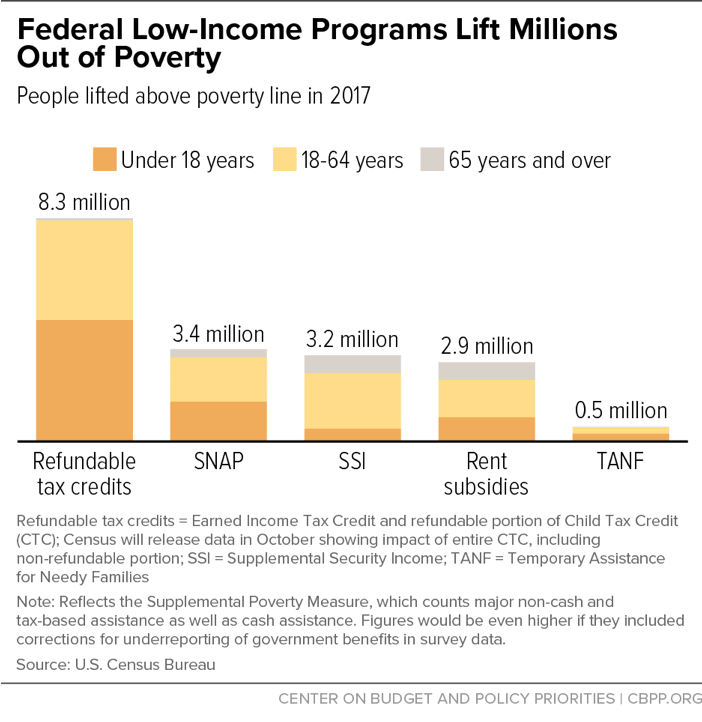BEYOND THE NUMBERS
Economic security programs like SNAP (food stamps), the Earned Income Tax Credit (EITC), and Social Security kept millions of people above the poverty line in 2017, the new Census figures show. President Trump and the House Budget Committee have called for deep cuts in several of the programs that, the data show, reduce poverty.
These Census figures use the Supplemental Poverty Measure (SPM), which accounts for taxes and non-cash benefits and presents a more complete picture of the impact of anti-poverty programs than the official poverty measure, which counts only cash income.
The new data show that in 2017:
- SNAP lifted 3.4 million people above the SPM poverty line ($27,005 for a typical two-adult, two-child renter family). More detailed past analyses have found that SNAP lifts more poor children out of “deep poverty” (that is, with incomes below half the poverty line) than any other program.
- Two tax credits for low- and moderate-income working families — the EITC and the low-income portion of the Child Tax Credit — together lifted 8.3 million people out of poverty, including 4.5 million children. These two tax credits lift more people out of poverty than any program except Social Security (which lifted 27.0 million out of poverty in 2017, 17.7 million of them seniors). And the tax credits lift more children out of poverty — 4.5 million — than any other program, followed by SNAP (1.5 million) and Social Security (1.4 million).
- Supplemental Security Income (SSI), which assists low-income seniors and people with disabilities, lifted 3.2 million people out of poverty.
- Rent subsidies lifted 2.9 million people out of poverty.
- Temporary Assistance for Needy Families (TANF) and state General Assistance programs lifted 544,000 people out of poverty.
These programs also reduced the severity of poverty for tens of millions of others by lifting them closer to the poverty line.
Yet both the President’s 2019 budget and the budget plan that the House Budget Committee adopted on a party-line vote on June 21 would deeply cut nutrition assistance through SNAP and income assistance programs such as TANF and SSI. The President’s budget would cut SNAP, where benefits now average only $1.40 per person per meal, by about 30 percent. It would also cut housing assistance, partly by significantly raising rents on the very poorest families.
The true impact of the programs discussed above on poverty is likely even greater than the figures suggest. Although the Census SPM findings provide a more complete view of the safety net’s anti-poverty effects than the official poverty figures, they still understate these effects because survey recipients often underreport their income from government programs. Household surveys depend on participants’ recollections over many months and typically fail to capture some income; the Census data are no exception. (For example, a CBPP analysis that corrects for underreporting finds that SNAP lifted 8.4 million people out of poverty in 2015, compared with 4.6 million in the uncorrected data.) The tax credit figures are slightly conservative for another reason: they only include the low-income portion of the Child Tax Credit.
Today’s data also show that TANF, which provides basic monthly income assistance to families with children, is less effective than the other four programs discussed above at reducing poverty. While SNAP and refundable tax credits have become more effective at reducing poverty and deep poverty over the past two decades, past studies have found TANF does far less to reduce poverty today than Aid to Families with Dependent Children, the cash assistance program that preceded TANF’s creation in 1996. TANF’s weaker effectiveness is due in part to policies that take away basic income assistance from families when a parent doesn’t meet rigid work requirements — policies that the Trump Administration and some in Congress have proposed as a model for other anti-poverty programs.

